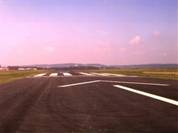
Airport Hildesheim

History
The first aircraft, an Etrich-Rumpler-Taube, landed on June 16, 1912 in Hildesheim. In the same year, the Hildesheimer Verein für Luftfahrt e.V. (Hildesheim Aviation Association) was founded. Initially, the activities of this association were limited to the ascent of hot air balloons. During World War I, all activities of the association were suspended. After the war, an airshow was organized in which two Hannoverian airplanes dropped parachutes and landed. Air traffic continued to increase. In the years 1924/25, voices in Hildesheim called for the construction of a “proper” airfield, as the aircraft had so far only taken off and landed on the Innerste meadows.
The city’s magistrate then decided in the winter of 1926/27 to build an airfield on the Steuerwald estate. On June 10, 1927, the airfield, at its current location, was officially opened by the then mayor, Ehrlicher, in a ceremony. The first aircraft to land at the present-day airfield was a Dornier-Komet belonging to Lufthansa, the operator of the Hildesheim airfield. The airfield was subsequently integrated into Lufthansa’s existing route network, for example: Berlin-Hannover-Hildesheim, Hildesheim-Munich, Hildesheim-Venice.
After the Great Depression, air traffic declined rapidly. In 1932, some members of MTV Eintracht Hildesheim founded the Luftsportverein Hildesheim (Hildesheim Air Sports Club). This club, dedicated exclusively to gliding, built its first own glider in the winter of 1932, which was successfully tested at Osterberg in the spring of 1933.
 In 1936, the Aviation School was established at the airfield. In 1938, units of the Airborne Squadron under the command of Captain Koch were stationed at the “Fliegerhorst Hildesheim” (Hildesheim Air Base). During the war, the construction of gliders continued. In 1944, the first winch launches by the club were carried out at Osterberg, west of the airfield. Additional units for national defense were stationed in Hildesheim from March 1944 onwards. On April 6, 1945, the airfield was damaged by bombs from the British Air Force.
In 1936, the Aviation School was established at the airfield. In 1938, units of the Airborne Squadron under the command of Captain Koch were stationed at the “Fliegerhorst Hildesheim” (Hildesheim Air Base). During the war, the construction of gliders continued. In 1944, the first winch launches by the club were carried out at Osterberg, west of the airfield. Additional units for national defense were stationed in Hildesheim from March 1944 onwards. On April 6, 1945, the airfield was damaged by bombs from the British Air Force.
With the end of the war, the Air Sports Club was practically dissolved as the British occupiers confiscated the airfield along with all its materials. The Aero Club was founded in June 1950, although flying was still not allowed at that time. However, the club had neither aircraft nor an airfield, let alone hangars. The club resumed building gliders and on June 16, 1952, the first aircraft, a Gö 4, was christened.
Until the authority to fly was regained, the military government had to approve every glider launch. In 1954, the first airshow after the war took place exclusively with gliders. In 1955, the Aero Club received its first powered aircraft (D-EDAX, an Auster). In June 1956, 34 private aircraft landed in a single day. On June 6, 1956, the Hildesheimer Allgemeine Zeitung called for a public discussion on the topic of “Can Hildesheim afford to abandon its airfield?” In 1957, the first civilian aircraft hangar was built.
In 1958, the Hildesheim Airport GmbH was established by the city of Hildesheim (75%) and the Aero Club (25%). In 1960, the Aero Club celebrated its tenth anniversary with a helicopter from the Army Aviation Squadron 1 landing in Hildesheim’s marketplace. Two additional aircraft hangars were built in 1966 and 1968. In 1975, the club celebrated its 25th anniversary with an airshow. The club now owns ten powered and glider aircraft.
In 1979, the 1st Army Aviation Battalion left Hildesheim, and the 1st Army Air Corps became its successor. This relocation made it necessary to conclude the airfield agreement in 1983, which regulated its civilian use. Under “British command,” the airfield continued to develop positively. However, the drawback was that, according to the joint usage agreement, only “sport flights” were allowed. In other words, the airfield was purely a sports facility. Consequently, the gliding division of the Aero Club is significant compared to the powered aircraft division.
 This changes abruptly on October 1, 1993. With the dissolution of the Warsaw Pact and the resulting reduction of troops in the West, the British presence in Hildesheim is also dissolved. The barracks become an industrial area, and the airfield becomes a special landing site. From then on, the airfield could be commercially utilized for the first time. This allowed for the establishment of a flight school as well as a workshop. The number of flight movements increased from around 5,000 to 15,000 today.
This changes abruptly on October 1, 1993. With the dissolution of the Warsaw Pact and the resulting reduction of troops in the West, the British presence in Hildesheim is also dissolved. The barracks become an industrial area, and the airfield becomes a special landing site. From then on, the airfield could be commercially utilized for the first time. This allowed for the establishment of a flight school as well as a workshop. The number of flight movements increased from around 5,000 to 15,000 today.
Due to this development and, in particular, the fact that the city of Hildesheim plans a 220-hectare commercial and industrial area north of the airfield, the airfield becomes an infrastructure facility. Consequently, the transformation into a Class II airfield with a paved runway is consistently pursued. The new runway was inaugurated on June 8, 2000, by the Lower Saxony Minister of Economics and Transport, Dr. Peter Fischer, together with Mayor Kurt Machens. Since September 2002, the airfield has had comfortable taxiways. Since July 1, 2009, the operation of the airfield has been managed by Flugplatz Hildesheim Betriebsgesellschaft (Hildesheim Airfield Operating Company).

 English
English German
German